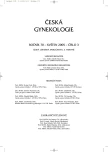Changes in Urethra Mobility after TVT Operation
Změny mobility uretry po TVT operaci
Cíl studie:
Cílem této studie bylo zjistit změny mobility uretry po úspěšně provedené TVT operaci.
Typ studie:
Prospektivní pilotní studie.
Název a sídlo pracoviště:
Gynekologicko-porodnická klinika VFN a 1. LF UK, Praha; Euromise, Karlova univerzita a Česká akademie věd, Praha.
Metodika:
Do prospektivní studie bylo zařazeno 101 žen s prokázanou stresovou inkontinencí. Následně po úspěšné TVT operaci bylo vyhodnoceno 90 žen. V rámci kompletního urogynekologického vyšetření bylo před operací provedeno UZ vyšetření v supinní poloze při standardní náplni močového měchýře 300 ml. V pravoúhlém systému souřadnic byla vyhodnocena poloha a mobilita celé uretry před operací. Kontrolní vyšetření bylo provedeno 3–6 měsíců po operaci. Vyhodnoceny byly změny vyvolané operací. K statistickému zpracování byl použit t-test, Wilcoxonův test, F test, Kruskalův-Wallisův test a ANOVA.
Výsledky:
Operace signifikantně snižuje mobilitu všech částí uretry v průběhu Valsalvova manévru, ale neovlivňuje klidové uložení uretry. Vysoká mobilita před operací implikuje i vysokou mobilitu po operaci. Operace má větší vliv u žen s vysokou mobilitou. Relativní změna mobility je u žen s různou předoperační mobilitou stejná. TVT působí na poměrné omezení mobility u všech žen stejně.
Závěr:
Informace o předoperační mobilitě je velmi důležitá a může zvýšit úspěšnost operace. Tah pásky by měl být pro pacientky s různou mobilitou uretry rozdílný.
Klíčová slova:
transperineální ultrazvuk, inkontinence moči, stresová inkontinence moči, TVT
Authors:
J. Mašata 1; A. Martan 1
; K. Švabík 1; P. Drahorádová 1; M. Pavlikova 2; J. Hlásenská 2
Authors‘ workplace:
Gynekologicko-porodnická klinika VFN a 1. LF UK, Praha, přednosta prof. MUDr. A. Martan, DrSc.
1; Euromise centrum, Karlova univerzita a Akademie věd, Praha, ředitelka prof. RNDr. J. Zvárová, DrSc.
2
Published in:
Ceska Gynekol 2005; 70(3): 220-225
Category:
Original Article
Overview
Objective:
The aim of our study was to asses changes in the mobility of the whole urethra after successful TVT procedure.
Design:
Prospective pilot study.
Setting:
Obstet. Gynecol Department, General Teaching Hospital, Ist Medical Faculty, Charles University, Prague; EuroMISE Centre of the Charles University and Academy of Sciences, Prague, Czech Republic.
Methods:
101 women with proven stressed urinary incontinence were included in the study. After the TVT procedure 90 women were evaluated. As a part of the complex urogynecological investigation before surgery the transperineal ultrasound scan was performed in supine position, urinary bladder was filled to 300 ml. In the orthogonal system of coordinates the position and mobility of the whole urethra before surgery were assessed. Control examination was done 3–6 months after the surgery. The changes induced by the surgery were assessed. For the statistical evaluation t-test, Wilcox test, F test, Kruskal-Wallis test and ANOVA were used.
Results:
Surgery significantly decreased the mobility of the whole parts of the urethra during maximal Valsalva, but the position at rest is not influenced. The women with high urethral mobility have high mobility after the surgery. The operation was more effect in patients with high mobility. Never the less the change of relative mobility is the same in all women.
Conclusions:
The information about the type of urethral mobility is important and may increase the success rate of TVT. Therefore the tension of the tape should be different for patients with different urethral mobility.
Key words:
transperineal ultrasound, stress urinary incontinence, TVT
Labels
Paediatric gynaecology Gynaecology and obstetrics Reproduction medicineArticle was published in
Czech Gynaecology

2005 Issue 3
Most read in this issue
- Nalbuphine in Obstetrical Analgesia
- Premature Separation of the Placenta – Etiology and Risk Factors
- „Mixed“ and „Miscellaneous“ Vulvovaginitis: Diagnostics and Therapy of Vaginal Administration of Nystatin and Nifuratel
- Metastasing and Relapsing „Low Grade“ Adenosquamous Metaplastic Breast Cancer – is There a Really Indolent Lesion? A Description of Three Cases and Review of Literature
